Daniel Sherrier's Blog, page 30
September 18, 2016
Today’s Super Comics — Green Lantern/Green Arrow #85-86 (1971)
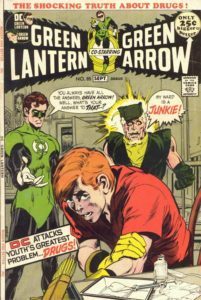 DC Comics brought Green Lantern down to Earth in the early 1970s. GL partnered with Green Arrow, initially playing the role of Hal’s conscience, and the duo fought the most fearsome super-villain of all time—social problems!
DC Comics brought Green Lantern down to Earth in the early 1970s. GL partnered with Green Arrow, initially playing the role of Hal’s conscience, and the duo fought the most fearsome super-villain of all time—social problems!
Few mad scientists or bug-eyed monsters were in the mix during Green Lantern/Green Arrow, but the green guys instead tackled issues ranging from racism to pollution, as well as drugs in #85 and 86. It was a DC series different from any that had come before, one much more grounded than the usual imaginative sci-fi fare the publisher specialized in during those days. And for a little over a year, it worked because of the other team-up the title featured—writer Dennis O’Neil and artist Neal Adams, two of the best in the business at the time, who excelled with down-to-earth takes on superheroes.
These comics aren’t subtle—they’re downright preachy at times—but they’ve got good messages for kids and adults alike. The drug storyline is not only a warning to stay away from drugs, but also a warning that the person you least expect can become hooked on them. In this case, Green Arrow’s former sidekick, Speedy, reveals he’s been using, and with the help of Black Canary, he strives to kick the habit. And this forces Green Arrow to confront the possibility that he may have failed in his most important duty—being the boy’s guardian.
Before this series, DC superheroes had seldom seemed so fallible or human.
Writer: Dennis O’Neil
Artist: Neal Adams
Publisher: DC Comics
How to Read It: back issues; Comixology; included in Green Lantern/Green Arrow vol. 2 (TPB)
Appropriate For: ages 10 and up
September 17, 2016
Today’s Super Comic — The Vision #5 (2016)
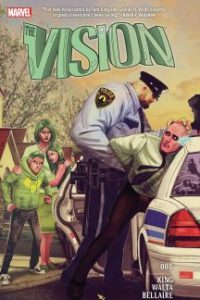 Never underestimate the importance of a story being told in exactly the correct medium. And The Vision, a series that takes the Avengers’ longtime android member and turns him into the patriarch of his own android family, can only be properly told as a comic book.
Never underestimate the importance of a story being told in exactly the correct medium. And The Vision, a series that takes the Avengers’ longtime android member and turns him into the patriarch of his own android family, can only be properly told as a comic book.
Sequential comic book art can most effectively convey how eerie and alien this family is, and the excellent artwork of Gabriel Hernandez Walta does just that. The Visions appear cold and stiff, almost wooden, but still very much alive. In a live-action movie, the characters might look silly or cartoonish, whereas in comic book art they exist on the same plane as the rest their environment. No need to add or polish them during post-production.
Animation? Maybe, but animation wouldn’t be able to match writer Tom King’s effective use of caption narration. Issue #5 juxtaposes an officer interrogating Vision and a list of the 37 times the Vision has saved the world—something that would be extraordinarily difficult to pull off on the screen or in a novel.
This comic is something different and special, and I’m looking forward to seeing where it goes.
Writer: Tom King
Artist: Gabriel Hernandez Walta
Publisher: Marvel Comics
How to Read It: recent back issues; Marvel Unlimited; Comixology; included in The Vision vol. 1: Little Worse Than a Man (TPB)
Appropriate For: ages 14 and up
Today’s Super Comic — The Vision #5
 Never underestimate the importance of a story being told in exactly the correct medium. And The Vision, a series that takes the Avengers’ longtime android member and turns him into the patriarch of his own android family, can only be properly told as a comic book.
Never underestimate the importance of a story being told in exactly the correct medium. And The Vision, a series that takes the Avengers’ longtime android member and turns him into the patriarch of his own android family, can only be properly told as a comic book.
Sequential comic book art can most effectively convey how eerie and alien this family is, and the excellent artwork of Gabriel Hernandez Walta does just that. The Visions appear cold and stiff, almost wooden, but still very much alive. In a live-action movie, the characters might look silly or cartoonish, whereas in comic book art they exist on the same plane as the rest their environment. No need to add or polish them during post-production.
Animation? Maybe, but animation wouldn’t be able to match writer Tom King’s effective use of caption narration. Issue #5 juxtaposes an officer interrogating Vision and a list of the 37 times the Vision has saved the world—something that would be extraordinarily difficult to pull off on the screen or in a novel.
This comic is something different and special, and I’m looking forward to seeing where it goes.
Writer: Tom King
Artist: Gabriel Hernandez Walta
Publisher: Marvel Comics
How to Read It: recent back issues; Marvel Unlimited; Comixology; included in The Vision vol. 1: Little Worse Than a Man (TPB)
Appropriate For: ages 14 and up
September 16, 2016
Today’s Super Comic — Justice League of America #171 (1979)
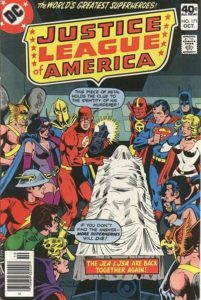 I always loved the “satellite era” of the Justice League of America, particularly when I was first discovering comics as a kid in the early ‘90s. Those late ‘70s/early ‘80s JLA books were always a treat to find in the quarter bins.
I always loved the “satellite era” of the Justice League of America, particularly when I was first discovering comics as a kid in the early ‘90s. Those late ‘70s/early ‘80s JLA books were always a treat to find in the quarter bins.
Justice League of America #171 is a good example. It begins with a joint meeting of the JLA and Justice Society of America (visiting all the way from the parallel world of Earth-2), and it ends by kicking off a locked-room murder mystery aboard the satellite HQ.
It’s harder to recommend for adults (other than for nostalgic reasons), but it shows what makes these classic JLA stories great for kids. These superheroes are adults and consummate professionals, and they respect and trust each other enough to freely share their secret identities. After the meeting, writer Gerry Conway takes time to show the two teams simply enjoying each other’s company, like a bunch of firefighters hanging out in the fire hall between calls, having forged close bonds in the course of their dangerous work. But when disaster strikes, they drop everything and leap into action.
If you’ve got kids interested in superheroes, show them old Justice League of America books from circa 1980. You’ll be giving them terrific role models.
Writer: Gerry Conway
Artists: Dick Dillan and Frank McLaughlin
Publisher: DC Comics
How to Read It: back issues; Comixology
Appropriate For: ages 8 and up
September 15, 2016
Today’s Super Comic — Uncanny X-Men #183 (1984)
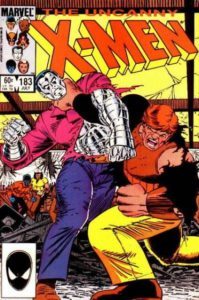 One of the nice things about comics—if a character acts like a total jerk, someone like the Juggernaut comes along to beat him senseless.
One of the nice things about comics—if a character acts like a total jerk, someone like the Juggernaut comes along to beat him senseless.
Uncanny X-Men #183 expertly blends soap opera and comic book sensibilities into a memorable outing. Colossus breaks Kitty Pryde’s heart (though seriously, that was a creepy relationship—he was 19 and she was 14…creepy), so Wolverine takes him out to a bar to chat man-to-man (with Nightcrawler tagging along/chaperoning). And by sheer random happenstance, the Juggernaut is there and Colossus bumps into him. Barfight ensues.
A nice touch on writer Chris Claremont’s part is having Wolverine decide to keep himself and Nightcrawler out of the battle—let Colossus endure the punishment he deserves for his heartlessness and maybe learn a lesson in the process.
It’s a classic issue, and the sort the X-Men excel at. Not every battle is about good vs. evil.
Writer: Chris Claremont
Artist: John Romita, Jr.
Inker: Dan Green
Publisher: Marvel Comics
How to Read It: back issues; Marvel Unlimited; Comixology; included in Essential X-Men vol. 5 (TPB)
Appropriate For: ages 10 and up
September 14, 2016
Today’s Super Comics — The Flash #201-206 (2003-04)
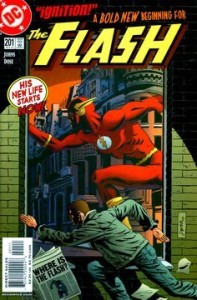 Nothing wrong with a change of pace once in a while, and that’s exactly what this Flash storyline is.
Nothing wrong with a change of pace once in a while, and that’s exactly what this Flash storyline is.
This Flash (Wally West) hadn’t kept his identity a secret since he took over his uncle’s mantle, but following tragic events in the previous storyline, a powerful being magically erased everyone’s knowledge of the Flash’s true name…including Wally’s. This sets the stage for a story of rediscovery (it’s almost Flash meets Hook, but far less upbeat).
The tone is darker than that of most Flash stories, and so is the color palette. Though the Flash is typically one of DC’s sunnier superheroes, Wally now works the overnight shift as a mechanic for the Keystone Police, thereby minimizing his exposure to daylight. Meanwhile, a new villain starts killing cops and framing Captain Cold for the murders. Alberto Dose’s art, particularly at the beginning, is pretty bleak and might make readers think they grabbed a Vertigo book by mistake.
Definitely not a typical Flash story—and I would never want this to be—but it works because it provides a sharp contrast to our usual expectations of a Flash story. And when that bright red streak starts cutting through the darkness, we remember why we love the character.
Writer: Geoff Johns
Artist: Alberto Dose
Publisher: DC Comics
How to Read It: back issues; Comixology; Flash: Ignition (TPB)
Appropriate For: ages 12 and up
September 13, 2016
Today’s Super Comic — Runaways #6 (2003)
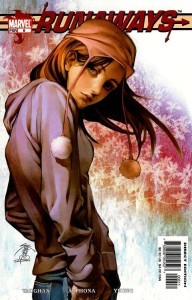 After I reviewed the first issue a few weeks ago, I had to keep reading. It’s been so long that I had forgotten many of the details … I just generally remembered that it was an excellent series.
After I reviewed the first issue a few weeks ago, I had to keep reading. It’s been so long that I had forgotten many of the details … I just generally remembered that it was an excellent series.
My memory got that part right. This series is a page-turner, thanks to crisp writing by Brian K. Vaughan and dynamic, expressive art by Adrian Alphonso. Each issue builds on the last as the young protagonists learn more about themselves and their evil parents.
Issue #6 completes the first volume, though it’s far from an ending. It’s more akin to the end of a pilot episode that sets the course for the continuing storyline. The action ramps up as the kids battle some of the parents, and we learn that someone’s loyalties might not be what they appear … but we don’t learn who that someone is.
There’s a great advantage to having a Marvel comic book starring an entirely new cast of characters—anything can happen. And that uncertainty sure is fun.
Writer: Brian K. Vaughan
Penciler: Adrian Alphona
Inker: David Newbold
Publisher: Marvel Comics
How to Read It: back issues; Marvel Unlimited; Comixology; included in Runaways vol. 1: Pride & Joy (TPB)
Appropriate For: ages 12 and up
September 12, 2016
Today’s Super Comic — Spider-Man #2 (2016)
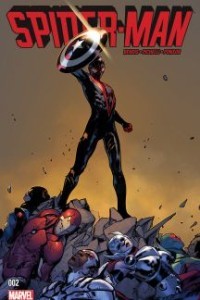 I’m convinced there’s room for two Spider-Men in the main Marvel Universe.
I’m convinced there’s room for two Spider-Men in the main Marvel Universe.
It makes sense, actually. As great as the Spider-Man concept is, it’s always had one significant flaw: Although his teen years appear to present never-ending challenges, eventually Peter Parker will grow up and become incredibly successful. But if he becomes too successful, then he loses that down-on-his-luck “everyman” quality that has so often defined him. Maintaining the status quo has led to such shark-jumping moments as Peter and Mary Jane’s marriage being magically erased from continuity.
Rather than embark on further silliness, another option is to let Peter grow up while a new kid experiences the headaches of juggling the awkward teen years and Spider-Man responsibilities. And that’s what Marvel seems to be doing these days. The Amazing Spider-Man shows us Peter Parker running a major company as basically the new Tony Stark, while Spider-Man shows us Miles Morales in more traditional Spidey scenarios, but updated for modern times. It’s like “Spider-Man: The Next Generation.”
In #2, part of his costume rips during a public battle, and suddenly the Internet is calling him “Black Spider-Man,” which Miles is none too thrilled about. His Spidey activities are hurting his grades at school. And an old associate of the original Spider-Man might be making some trouble for the new kid.
I have a feeling this series will continue to entertain for quite a while. And I should really get around to reading the Ultimate series that introduced Miles.
Writer: Brian Michael Bendis
Artist: Sara Pichelli
Publisher: Marvel Comics
How to Read It: recent back issues; Marvel Unlimited; Comixology
Appropriate For: ages 10 and up
September 11, 2016
Today’s Super Comic — Mockingbird #1 (2016)
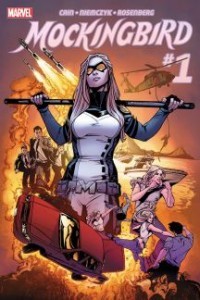 Once you’ve read a whole bunch of comic books over the course of twenty-five years, you often know more or less what to expect. But I did not expect the first issue of Mockingbird to be a sequence of examinations in a SHIELD medical facility…or for such a thing to be this entertaining.
Once you’ve read a whole bunch of comic books over the course of twenty-five years, you often know more or less what to expect. But I did not expect the first issue of Mockingbird to be a sequence of examinations in a SHIELD medical facility…or for such a thing to be this entertaining.
It’s nice to be surprised, and this was a nice surprise indeed, full of mystery, sarcasm, and amusing visual gags.
The issue explains very little at this point, but it keeps you wondering what’s going on and what will happen in future issues…which is exactly what it needed to do.
I’m not familiar with writer Chelsea Cain or artist Kate Niemczyk, but this issue makes a tremendous first impression. I definitely need to see where the series goes from here.
(And in case you didn’t know, Mockingbird is the codename of Bobbi Morse, Adrianne Palicki’s character on the Agents of SHIELD television series. Now you know! Or you know again.)
Writer: Chelsea Cain
Artist: Kate Niemczyk
Publisher: Marvel Comics
How to Read It: recent back issues; Marvel Unlimited; Comixology
Appropriate For: ages 12 and up
September 10, 2016
Today’s Super Comic — Invincible Iron Man #7 (2016)
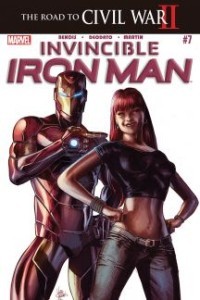 Brian Michael Bendis writes Tony Stark and Mary Jane Watson talking for much of the issue. So of course you know it’s highly entertaining.
Brian Michael Bendis writes Tony Stark and Mary Jane Watson talking for much of the issue. So of course you know it’s highly entertaining.
That might have been enough, but the issue also introduces an intriguing new villain, gives us a cameo of another new character who will play an important role, and makes room for Spider-Man and War Machine.
Everything I’ve previously said about this series still applies. It hasn’t let me down yet.
And don’t let the “Road to Civil War II” logo dissuade you if you’re averse to crossovers. The issue is entirely accessible if you’ve just been following this series.
Writer: Brian Michael Bendis
Artist: Mike Deodato
Publisher: Marvel Comics
How to Read It: recent back issues; Marvel Unlimited; Comixology
Appropriate For: ages 12 and up



